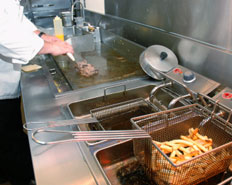Empty restaurants are everywhere. Some of those restaurant sites may have great potential and offer significant cost savings, provided the astute operator is willing to adjust expectations. It’s important to determine if the restaurant is empty because of the current economic recession, or if there are additional factors that contributed to its demise. The basic issues that need to be analyzed prior to purchase include: location, visibility, accessibility, demographics, building size, parking, and site considerations. Assuming these considerations don’t pose any problems, then take a good look at the back of house and the kitchen.
The Kitchen as a Determining Factor
The age, condition, and layout of the kitchen and other back-of-house areas can often be critical factors in determining if an empty restaurant building makes sense for retrofitting your brand. The equipment, plumbing, electrical, mechanical ventilation, floor coverings, and ceilings are all required components of the commercial kitchen that make the build out very expensive. Remember that someone has already spent a lot of money on this kitchen, and your potential windfall comes from maximizing the benefit of the original financial investment by reusing as much of the existing kitchen as possible. Work closely with your operations experts and equipment suppliers to see if the existing layout, and maybe some of the equipment, can be reused for your restaurant.
Taking a Practical Approach to Equipment Can Be a Plus
You know the cost of kitchen equipment. If some of the existing equipment can be serviced and reused, the savings can extend beyond the actual equipment costs. Give particular consideration to reusing the big-ticket items. The cooking equipment may need to be modified to accommodate your menu, no matter the condition. But there is a good chance the dishwashing machine, stainless steel sinks, walk-in coolers and freezers, and hoods could be reused, even if they are not exactly what you are used to at your other locations. If the hood is absolutely too small for your cooking processes, consider adding another smaller hood instead of replacing it. If the walk-ins are too small, consider adding reach-ins, or a separate, smaller walk-in to supplement the existing equipment. There are other, less-expensive items that can more than likely be reused, such as stainless steel worktables and shelving.
Capitalizing On the Kitchen’s Existing Infrastructure Can Yield a Windfall
Even if you decide that most or all of the equipment has to be replaced, try to capitalize on the existing infrastructure by replacing the equipment in its original configuration and location. Relocating the dishwashing machine can lead to trenching the concrete to relocate several drains, and maybe even the grease interceptor. Replacing or relocating the hood may entail new exhaust fans, grease ducts, duct wrap, and the fire suppression system. Overall, reconfiguring the kitchen zones can add up to major expenditures. The modification could require relocating floor drains, trench drains, floor sinks, drain lines, water lines, gas lines, electric circuits, ductwork, sprinkler heads, and other infrastructure elements. In order to maximize cost savings in the back of house, reuse what you can and leave the layout of the previous restaurant mostly intact. Remember, the customer never sees the back of house.
Spend the Money Where You Get Credit from the Customer
The more money you save in the kitchen, the more you can justify spending in the front of house. A new entry vestibule, seating package, restroom tile, light fixtures, signage—these are the types of investments that the customer can see, feel, and appreciate. Keeping an open mind about your operational requirements in the back of house can be the key to a successful reuse of an empty restaurant building.











